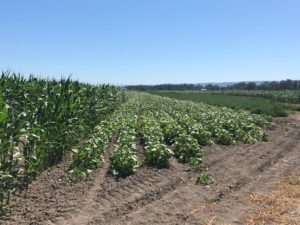Cranes, Cows, and Crops
Columbia Land Trust works with a local dairy to harvest crops in the Vancouver Lake Lowlands while preparing for the arrival of sandhill cranes
As the crisp fall season makes its way through the Northwest, Columbia Land Trust prepares for the arrival of an abundance of sandhill cranes to its experimental farmed crops in the Vancouver Lake Lowlands, a site also known as Cranes’ Landing. The Land Trust has been farming the property every year since the Port of Vancouver donated the 527-acre property in 2016. Over 400 acres of various crops have been planted, attracting the cranes in record numbers. The cranes have adapted to these fields for staging and feeding making the area a major pitstop and wintering ground along the Pacific Flyway.
In addition, Cranes’ Landing has proven to be a valuable resource for a local dairy farm. In September of 2019, Columbia Land Trust began working with a local dairy to harvest crops at Cranes’ Landing to help provide a local food source to supplement the dairy cows in their production of milk and other products.
“Cranes’ Landing is close in proximity to the dairy’s operations,” said Natural Area Manager Dan Friesz. “With more farmland being lost to development and other crops, like berries, Cranes’ Landing provides an excellent opportunity for this local dairy to continue to produce high quality products without having to travel out of the county or into Oregon.”
It’s a win-win. By harvesting tall standing crops, like alfalfa, oats, and wheat, the Land Trust provides resources for local dairy cows so farmers don’t have to travel far to the harvested crop area and the harvesting provides secure landing areas for the cranes to begin setting up camp after a long migration. These open areas adjacent to other crops, like soybeans and corn, allow the cranes to safely move and forage around the property while keeping an eye out for predators.
“The spring wheat, oats, and alfalfa grow well on the Cranes’ Landing property.” said Friesz. “These crops are to be harvested because if left standing, the rain and wind will eventually knock them over and the cranes will not utilize these areas until late winter or early spring. The cranes can’t see predators entering standing crops.”
The local dairy will take advantage of three cuttings of alfalfa for feed for the cows and the spring wheat and oats will provide a forage supplement as well as straw bales for bedding material during the winter.

Cranes’ Landing has grown into a property that offers many benefits for several communities and wildlife that pass through. The property is a piece to a bigger picture of regional conservation lands, including Ridgefield National Wildlife Refuge, Shillapoo Wildlife Area, and Oregon’s Sauvie Island Wildlife Area.
Watch a short video about the conserved site: